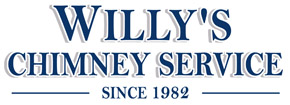
Frequently Asked Questions and Answers
Why line the chimney?
• Prevent deterioration• Insulate combustible materials
• Vent deadly carbon monoxide
What causes chimney draft?
• Flue blockage• Improper flue size
• Insufficient chimney height
The National Fire Protection Association Standard 211 says, "Chimneys, fireplaces, and vents shall be inspected at least once a year for soundness, freedom from deposits, and correct clearances. Cleaning, maintenance, and repairs shall be done if necessary." It takes into account the fact that even if you don't use your chimney much, animals may build nests in the flue or there may be other types of deterioration that could make the chimney unsafe to use.
The Chimney Safety Institute of America recommends that open masonry fireplaces should be cleaned at 1/4" of sooty buildup, and sooner if there is any glaze present in the system. Factory-built fireplaces should be cleaned when any appreciable buildup occurs. This is considered to be enough fuel buildup to cause a chimney fire capable of damaging the chimney or spreading to the home.
The purpose of a chimney liner is to keep the heat of flue gases inside the chimney so the chimney can't overheat the nearby combustible material, such as the framing and walls of your house, and possibly cause a fire. The liner also keeps carbon monoxide, moisture, smoke, creosote, and other products of combustion from seeping through the bricks and mortar of your chimney and leaking into your home. Most masonry chimneys are constructed with an inner liner of clay tiles. Learn more about carbon monoxide
If your chimney liner is cracked, broken, or missing then it needs to be replaced. Cracked clay liner tiles and the deterioration of mortar joints between liner tiles can lead to carbon monoxide leakage into the house. Cracks in the chimney liner can also cause dangerous heat transfer to combustible material surrounding your chimney.
The primary culprit for chimney breakdown is the acidic moisture that comes from condensed flue gases. This acidic moisture attacks the chimney from the inside. That is why a chimney may look good from the outside, but the inside can be a totally different story! Years of normal use with hot and cold cycles and seasonal weather conditions all take their toll on a chimney.
The advent of high efficiency furnaces has helped conserve earth's natural resources, and has also meant lower heating bills for homeowners. At the same time, high efficiency furnaces, as their name indicates, extract more heat from a given amount of fuel than conventional furnaces. Combustion is more complete and less heat is lost up the chimney. In turn, the flue seldom has a chance to "dry out" as older furnaces have allowed. Once flue gases drop to 120 F, unwanted condensation begins. Herein lies one side effect of high efficiency furnaces - excessive moisture in the flue. The combustion process itself, too, leads to condensation in the chimney. Water vapor is a by-product of burning fuel. When 1 cubic foot of gas is burned, 2 cubic feet of water vapor is created. Traditionally built chimneys with clay liners will not last under this moisture assault. Stainless steel relining is the best solution for moisture attack.
Chimney fires occur when deposits of carbon and dust accumulate in a chimney and are set alight by sparks or flames from an open fire. When wood burns slowly and produces smoke, the smoke condenses on the cool inner surface of the chimney and produces creosote deposits. Creosote is a highly flammable material. If it ignites at the base of the chimney, it can produce a raging fire that travels up the chimney at extremely high temperatures. Most solid fuels create some kind of soot which without regular cleaning of chimneys builds up in the flue and eventually catches fire.
In order for the fire to burn properly, the chimney must pull combustion air through the fireplace or stove. At times, however, there is a negative pressure in the chimney causing chimney draft. There are several causes of chimney draft such as improper flue sizing, flue blockage, resistance from below, insufficient chimney height, and so on. Relining a chimney often has a positive effect on chimney draft.
A chimney professional would most likely use a video inspection system so he could systematically inspect your chimney. Such an inspection will be able to show any cracks in the tiles, even small ones, or any damage to the mortar between the clay chimney tiles.
Carbon monoxide is a colorless, odorless, tasteless, yet highly toxic gas. It forms when there is a reduced availability of oxygen, such as when operating a chimney or stove. Sadly, families suffer each year from the poisonous effects of carbon monoxide due to unsafe chimney conditions.
It happens thousands of times each year; damaged chimneys resulting in disaster. Poisonous carbon monoxide gas leaks through cracks in the flue lining and into the home. Even small amounts can make you and your family sick. There is also the risk of a chimney fire turning into a house fire. Highly combustible creosote can leak through even small cracks in clay linings. Once ignited, a creosote fire can find its way through the cracks, and dangerously increase chimney heat. Or the flames can simply penetrate cracks in the mortar and ignite a home. Having a few cracked flues is serious business.
If you are using the chimney to vent a fireplace, wood, coal or pellet stove or a gas or oil appliance, the flue should be inspected and cleaned once a year. You should also have your chimney inspected if you have experienced a chimney fire. The sudden rise in temperatures within the flue associated with a chimney fire is often the main cause of tiles cracking.
If a clay tile liner was never originally installed, or when the tile lining cracks, crumbles and deteriorates over time, you need a new liner. Water damage, chimney fires, or just age can cause the deterioration of your clay liner. One of our chimney sweeps would be happy to help you examine your chimney needs.
All liner pipe is made of prime stainless steel. Depending on the application several alloys are used...
- 304L stainless is used for wood burning appliances.
- 316Ti stainless is for all fuels (wood, oil, gas, coal)
- AL29-4C stainless is best used for high efficiency gas and oil appliances
A UL listing stands for Underwriters Laboratory Inc, an independent, not-for-profit product-safety testing and certification organization. It is responsible for setting safety standards and testing various industries and appliances. UL runs many stringent and rigorous tests in order to assure that only safe and reliable products receive the UL listing. A UL listing informs the consumer that the product he is buying has been suitably tested and found acceptable for the application for which it was intended..
The National Chimney Sweep Guild (NCSG) is a national organization developed to promote professionalism in the chimney industry, public awareness of chimney safety issues and provide support and a professional network to chimney professionals throughout North America. Membership in the NSCG shows that a chimney professional is actively involved in keeping up with current practices in chimney servicing, maintenance and repair, and has up-to-date knowledge of the latest chimney-related products, tools, and techniques.
The Chimney Safety Institute of America (CSIA) is a non-profit educational foundation that has created a certification program for chimney sweeps within the United States. CSIA devotes its resources to educating the public, chimney service professionals and other fire prevention specialists, and the insurance industry about the prevention and correction of chimney venting system hazards.

